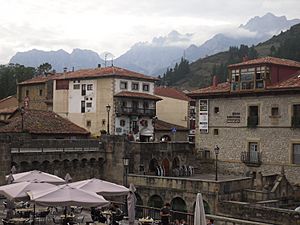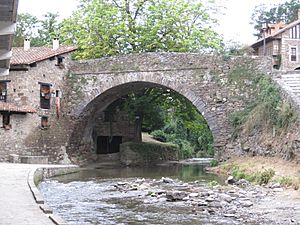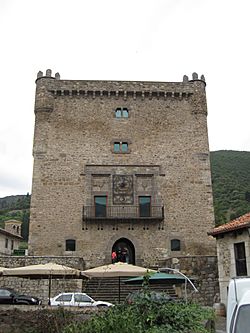Potes facts for kids
Quick facts for kids
Potes
|
|||
|---|---|---|---|
 |
|||
|
|||
| Country | |||
| Autonomous community | |||
| Province | Cantabria | ||
| Comarca | Liébana | ||
| Judicial district | San Vicente de la Barquera | ||
| Area | |||
| • Total | 7.64 km2 (2.95 sq mi) | ||
| Elevation | 291 m (955 ft) | ||
| Population
(2018)
|
|||
| • Total | 1,350 | ||
| • Density | 176.7/km2 (457.7/sq mi) | ||
| Demonym(s) | Lebaniego/a | ||
| Time zone | UTC+1 (CET) | ||
| • Summer (DST) | UTC+2 (CEST) | ||
| Postal code |
39570
|
||
| Official language(s) | Spanish | ||
Potes is a small town in the Cantabria region of Spain. It is the main town of the Liébana area and is right in the middle of it. Potes is surrounded by other towns like Cillorigo de Liébana to the north, Camaleño to the west, Vega de Liébana to the south, and Cabezón de Liébana to the east.
Contents
Geography of Potes
The town of Potes is special because it sits where four valleys meet. Two rivers, the Quiviesa and the Deva, also join here. The Deva River starts high up in the Picos de Europa mountains.
Potes and the Liébana region have a warm, sunny climate, almost like the Mediterranean. This special weather lets people grow things like vines for grapes, walnut trees, and poplar trees. The Arabedes mountain, which is 694 meters (about 2,277 feet) tall, looks over the town.
History of Potes
Potes is in a very important spot where the Deva and Quiviesa rivers meet. This made it a good place for people to settle long ago. Not much is known about very early people living here, but the Romans called the area "Pontes," which means "bridges."
A village was started here in the 8th century by Alfonso I of Asturias. Potes was first mentioned in a written paper in the year 847. This paper talked about the local church and the town itself. Later, in the 10th century, Potes became the main administrative center for the Liébana area. By the 13th century, Potes was seen as an important town and was recognized by the king.
During the Middle Ages, Potes was involved in conflicts between powerful families. In 1444, the king decided that the Marquis of Santillana would control Potes. The Marquis made Potes the capital of Liébana and built a large tower, which is now called the Torre del Infantado. Other important buildings, like the Tower of Orejón de la Lama and the San Cayetano bridge, were also built around this time.
In more recent times, Potes was still controlled by a powerful lord, the Duke of Infantado, who chose the town's mayor. Many people from Potes traveled to America, and the wealth they brought back helped build many nice buildings in the town. In 1822, Potes got its own town council.
During the Spanish Civil War, Potes suffered a big fire that destroyed much of the old town. But it was rebuilt! In 1983, the old town was officially recognized as a Conjunto Histórico, meaning it's a special historical place.
Economy and Tourism
The main way people in Potes make money is through tourism. Many visitors come because Potes is located near the beautiful Picos de Europa mountains. The town is on the national road N-621. The closest big city, Santander, is about 100 kilometers (62 miles) away.
Sites and Monuments to Explore
- The Old Town: This part of Potes is a historical monument. It has many narrow streets and steps, giving it a cool medieval feel.
- Torre del Infantado: This tower is a symbol of Potes. It was built in the 15th century and has four floors, looking like a strong stone cube. Today, the town council meets here.
- San Vicente Church: The old Gothic church of San Vicente was built in the 15th century. It was later replaced by a new parish church in the 19th century. This new church has beautiful altarpieces from the 18th century and a statue of Saint Vincent, who is the town's patron saint. In the town square, there's a monument to Jesús de Monasterio, a famous violinist who was born in Potes.
- San Cayetano Bridge: This old bridge has stood over the River Quiviesa since the 13th century. Near one end of the bridge is the Ermita de San Cayetano, a small chapel with old wooden doors. You can also see the Torre de Orejón de la Lama nearby. This tower was built between the 15th and 17th centuries and now hosts exhibitions and cultural events.
- Other Historic Houses: You can also see other interesting old houses, like the Casona de la Canal (from the 18th century) and the Torre de la Familia Osorio (from the 17th century). San Marcial Street, also from the 18th century, has the family crests of the Campillo family and is where Jesús Monasterio was born.
- Ermita de la Virgen del Camino: This chapel from the 18th century is in the La Serna district. It has an altarpiece from the same century.
- Convent of San Raimundo: This convent was built in the early 17th century by Benedictine monks. Today, only the cloister (a covered walkway around a courtyard) remains. It now has an exhibition about the Picos de Europa and the Liébana region.
- Ermita de la Virgen de Valmayor: This chapel is located outside the village on the road to Vega de Liébana. It was built in the 16th century and has an 18th-century altarpiece with an image of the Virgin of Valmayor. Every year on August 15th, this image is carried in a special procession.
Population Changes Over Time
| Historical population | ||||||||||||||||||||||||||||||||||||||||||||||
|---|---|---|---|---|---|---|---|---|---|---|---|---|---|---|---|---|---|---|---|---|---|---|---|---|---|---|---|---|---|---|---|---|---|---|---|---|---|---|---|---|---|---|---|---|---|---|
|
|
|||||||||||||||||||||||||||||||||||||||||||||
Town Leadership
The current mayor (called Alcalde in Spain) of Potes is Francisco Javier Gómez Ruiz from the PP. Here are the results from some past local elections:
|
|
||||||||||||||||||||||||||||||||||||||||
Local Food and Drink
One of the most famous dishes from Potes is a hearty chickpea stew called Cocido Lebaniego. Other tasty products from Potes include different kinds of local cheeses, honey, and a strong grape brandy called Orujo. This brandy is made from wine grown right in the valley.
Festivals and Events
Potes has many fun festivals and events throughout the year:
- Saint Vincent's Day: On January 23rd, Potes celebrates its patron saint, Saint Vincent. This day includes traditional dances and festivities.
- Procession of Santuca: In early May, the Liébana region hosts one of the biggest processions in Spain, called the Santuca. A statue of the Virgen de la Luz is carried from its chapel to Santo Toribio de Liébana.
- Procession of the Virgen de Valmayor: On August 15th, the image of the Virgen de Valmayor is carried in a procession. This event features dancing, music, and songs from the Middle Ages.
- Exaltation of the Cross: From September 13th to 17th, Potes celebrates the Exaltation of the Cross. The Monastery Santo Toribio claims to have a small piece of the True Cross. This holiday is considered a Regional Tourist Interest event.
- Feast of the Orujo: In November, there's a big non-religious event called the Feast of the Orujo, celebrating the local grape brandy.
See also
 In Spanish: Potes para niños
In Spanish: Potes para niños








